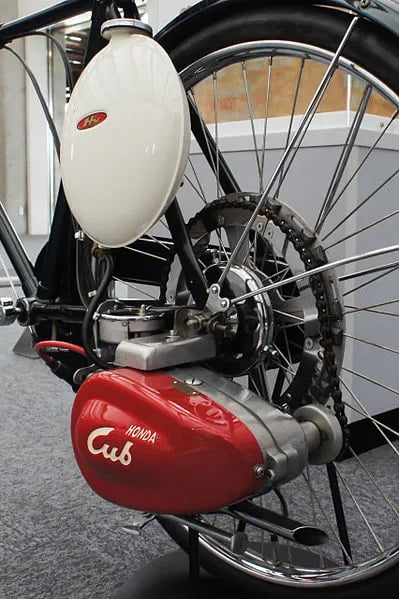The Honda Cub F: From Little Cub to Giant Corporation
The Honda Cub F, part of the Super Cub series, was introduced in 1952 and marked the beginning of Honda's post-war endeavors. It was not a traditional motorcycle but rather a bicycle with an auxiliary engine. The Cub F laid the foundation for the Super Cub, which became a global phenomenon and remains in production today. With millions of units sold, it continues to be a symbol of reliable and accessible urban transportation and a testament to Honda's commitment to innovation.
MOTORIZED BICYCLES CYCLEMOTORSMOPEDSVINTAGE MOPEDSHONDA JAPAN 1950'STWO STROKE
11/7/20232 min read


The Honda Cub F: From Little Cub to Giant Corporation
The Honda Cub F, a member of the iconic Super Cub series, holds a special place in the world of motorcycles. Since the first "Cub" model was introduced in 1952, it has been a symbol of reliable and accessible urban transportation. In this comprehensive article, we will explore the history, evolution, and significance of the Honda Cub F.
The Birth of the Cub F
The "Cub" name, which would become synonymous with Honda's two-wheelers, first appeared in 1952 when Honda introduced the Cub F. At that time, Japan was still emerging from the aftermath of World War II, and the occupation by Allied forces had recently ended. The release of the Cub F marked one of Honda's early post-war endeavors.
However, it's worth noting that when we talk about the Cub F, we are referring to the engine and its related components, not the bicycle-like image often associated with it. The Cub F was not a traditional motorcycle; it was, in fact, a bicycle with an auxiliary engine. One distinctive feature of the Cub F was the white fuel tank and the red engine. This color combination later became synonymous with Honda's brand identity.
The engine itself was a 50cc 2-stroke powerplant. In the second model introduced in 1953, the engine's displacement was increased to 58cc. These early Cub F models were sold through bicycle shops across Japan.
Cub F Ⅱ: Evolution and Minor Changes
In 1953, Honda introduced the Cub F Ⅱ, which brought about some minor changes to the original design. This new model was designed for domestic use in Japan and continued the legacy of the Cub F. It was remarkable that these early iterations of the Cub series were sold in cardboard boxes, underlining the simplicity and practicality of the concept.
The Cub F's Basic Specifications
Model Name: Cub F Ⅱ
Model Year: 1953
Market: Domestic (Japan)
Engine Type: 2-Stroke
Cylinder Configuration: Single-cylinder
Cooling: Air-cooled
Displacement: 58cc
The Super Cub Legacy
The Cub F laid the foundation for what would later become the Super Cub, one of the most successful and beloved series of motorcycles in the world. The Super Cub, which includes the legendary C100 model, became a global phenomenon and played a pivotal role in changing the perception of two-wheelers.
Today, the Super Cub remains in production, and its influence can be seen in countless other motorcycles and scooters worldwide. With millions of units sold over the decades, it continues to be a symbol of reliable, efficient, and accessible urban transportation.
The Honda Cub F may have been a humble beginning, but it was the spark that ignited the enduring legacy of the Super Cub. It stands as a testament to Honda's commitment to innovation and its dedication to providing practical and reliable transportation solutions to people around the world.
